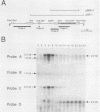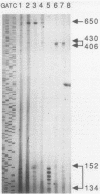Abstract
The cyclic nucleotide phosphodiesterase (phosphodiesterase) plays essential roles throughout the development of Dictyostelium discoideum. It is crucial to cellular aggregation and to postaggregation morphogenesis. The phosphodiesterase gene is transcribed into three mRNAs, containing the same coding sequence connected to different 5' untranslated sequences, that accumulate at different times during the life cycle. A 1.9-kilobase (kb) mRNA is specific for growth, a 2.4-kb mRNA is specific for aggregation, and a 2.2-kb mRNA is specific for late development and is only expressed in prestalk cells. Hybridization of RNA isolated from cells at various stages of development with different upstream regions of the gene indicated separate promoters for each of the three mRNAs. The existence of specific promoters was confirmed by fusing the three putative promoter regions to the chloramphenicol acetyltransferase reporter gene, and the analysis of transformants containing these constructs. The three promoters are scattered within a 4.1-kilobase pair (kbp) region upstream of the initiation codon. The late promoter is proximal to the coding sequence, the growth-specific promoter has an initiation site that is 1.9 kbp upstream of the ATG codon, and the aggregation-specific promoter has an initiation site 3 kbp upstream.
Full text
PDF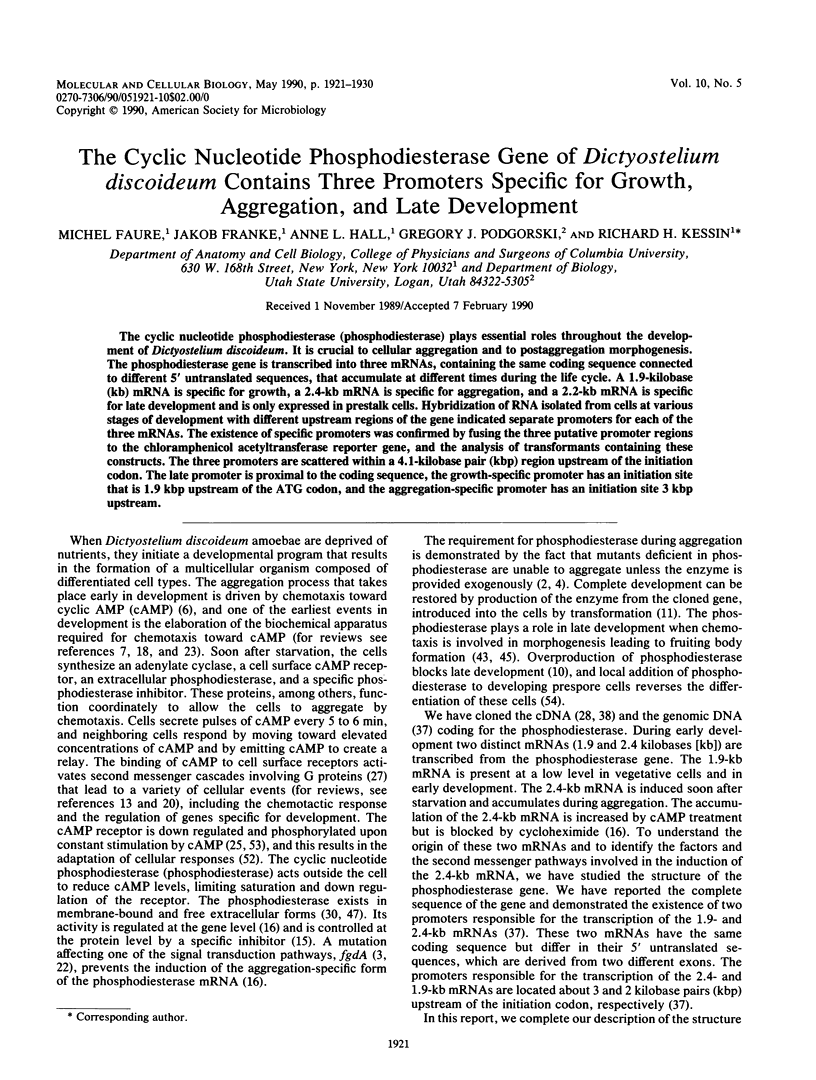
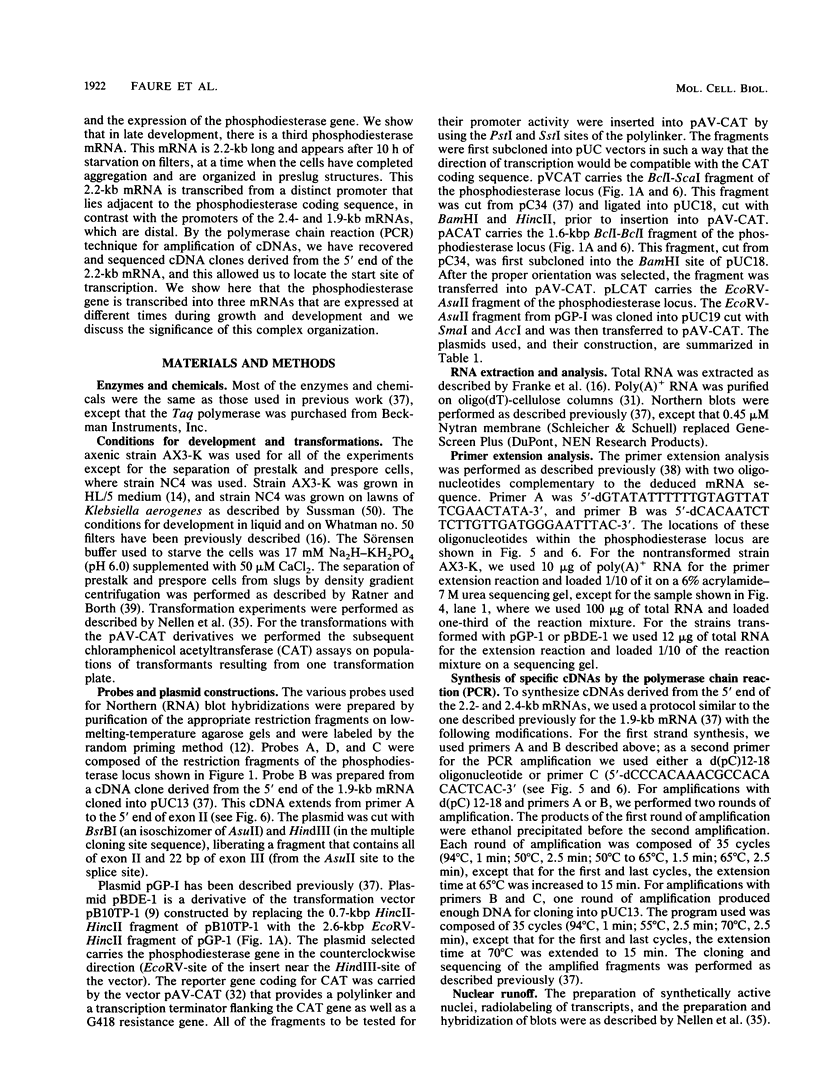
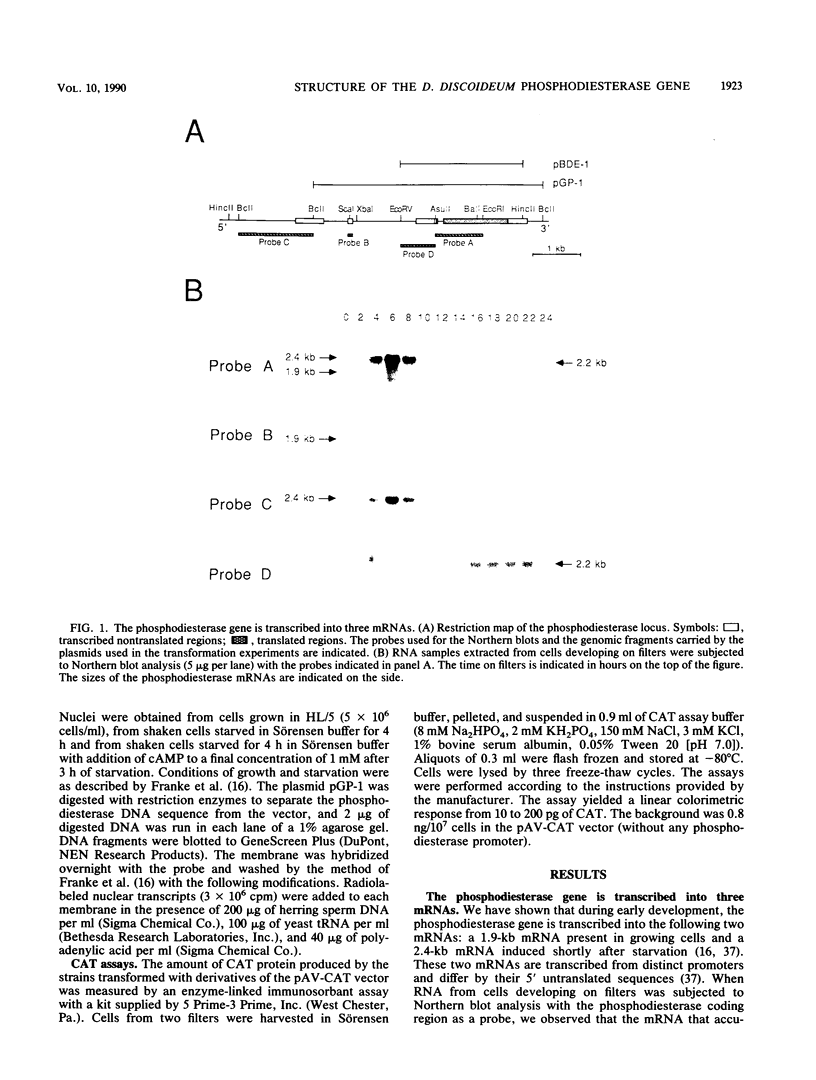
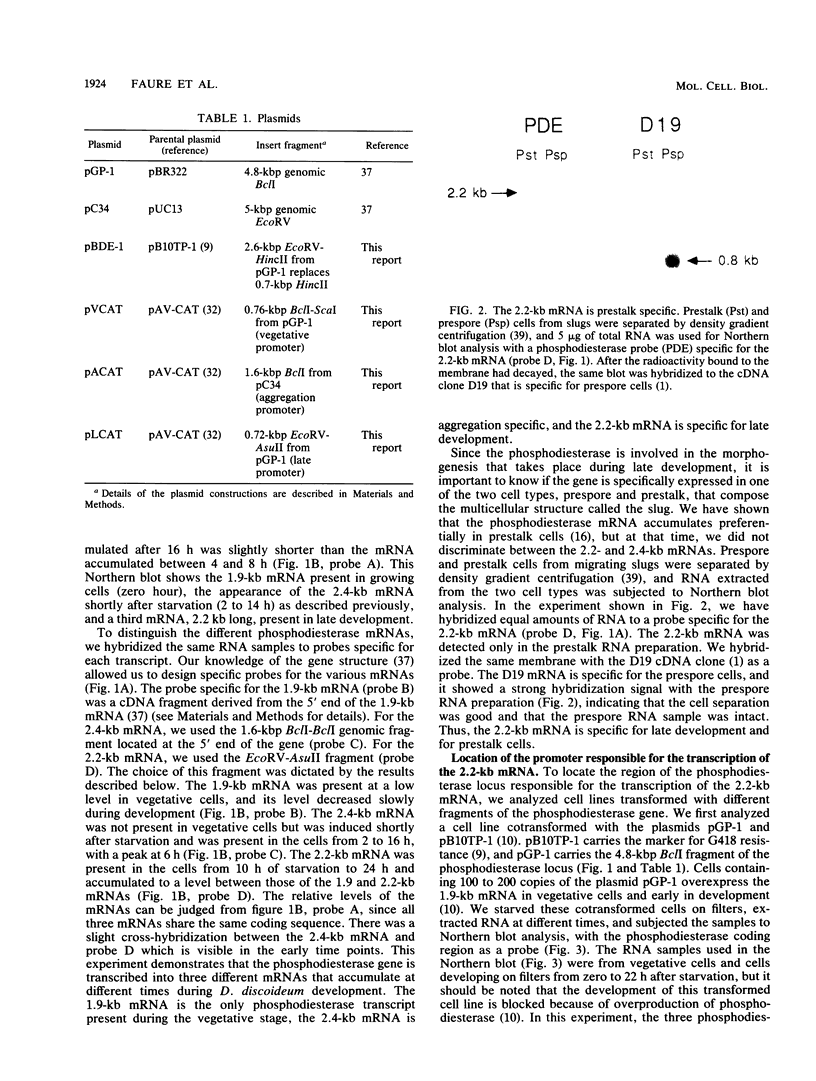
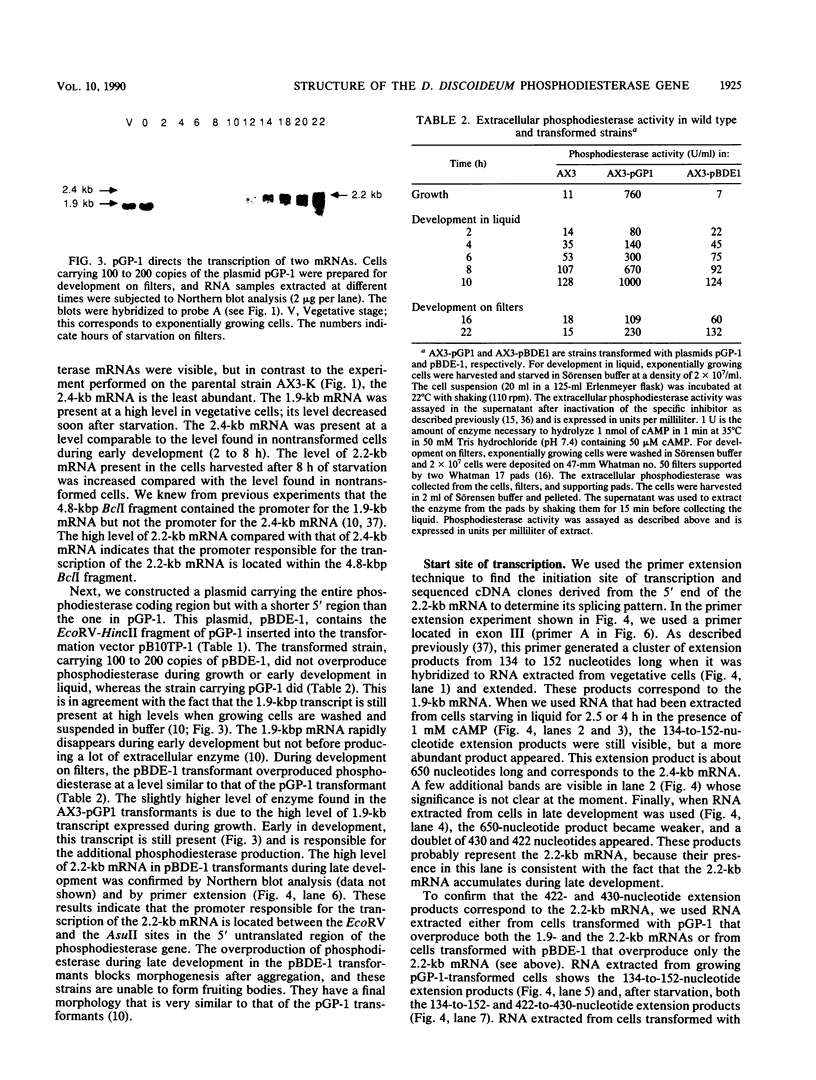
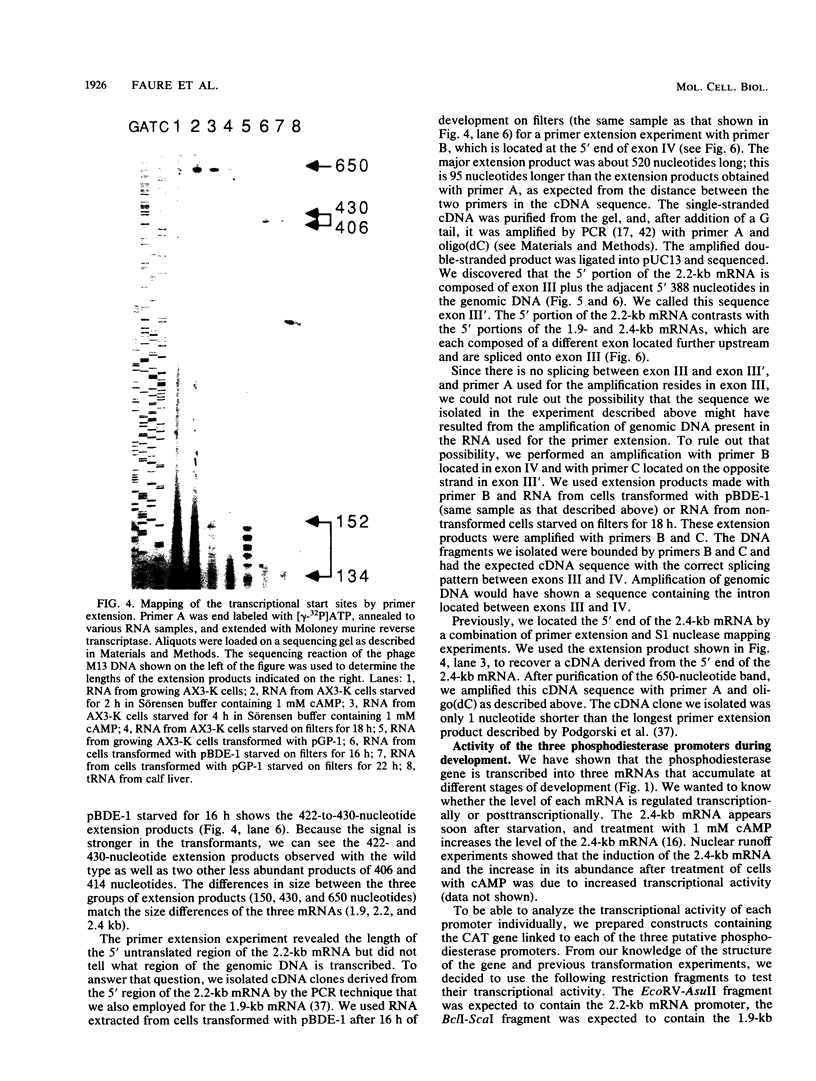
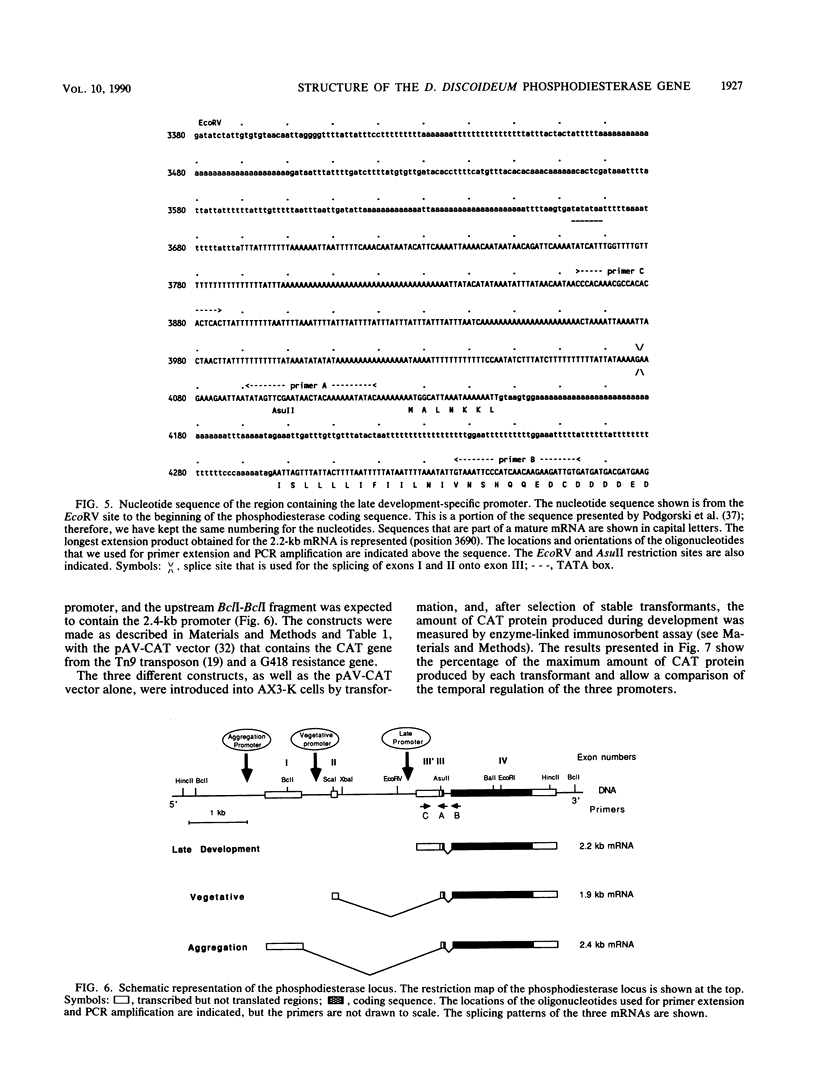

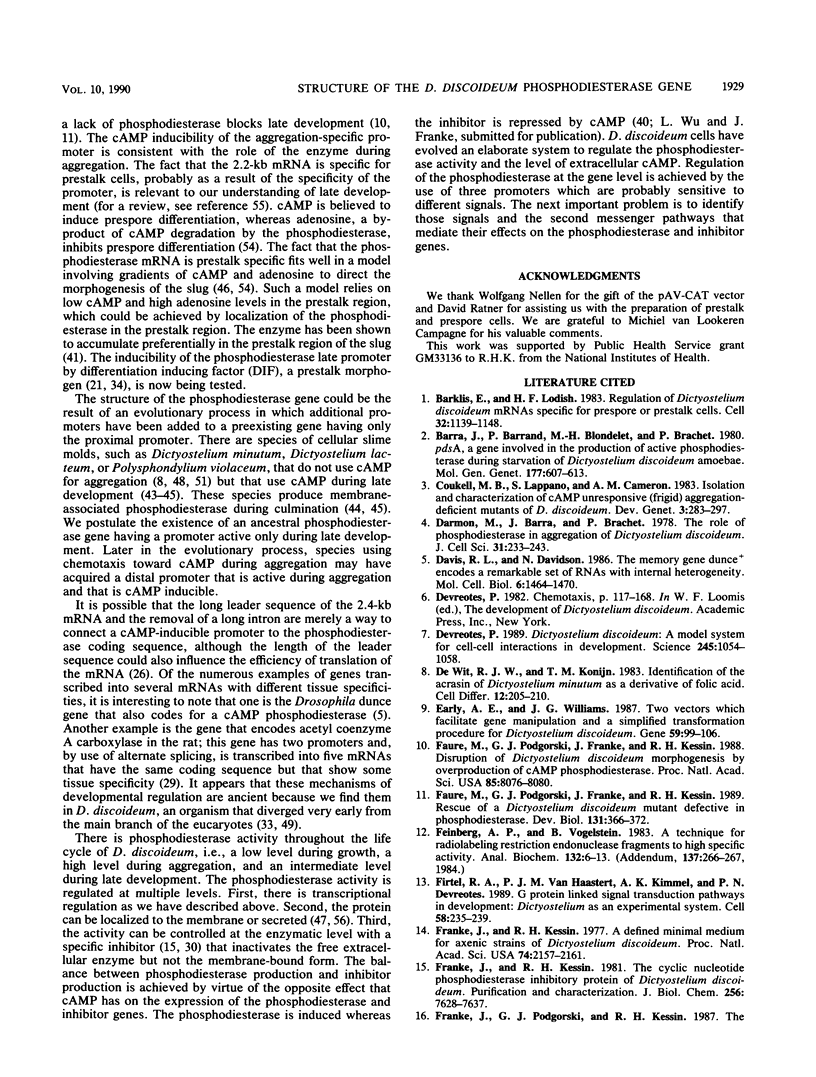
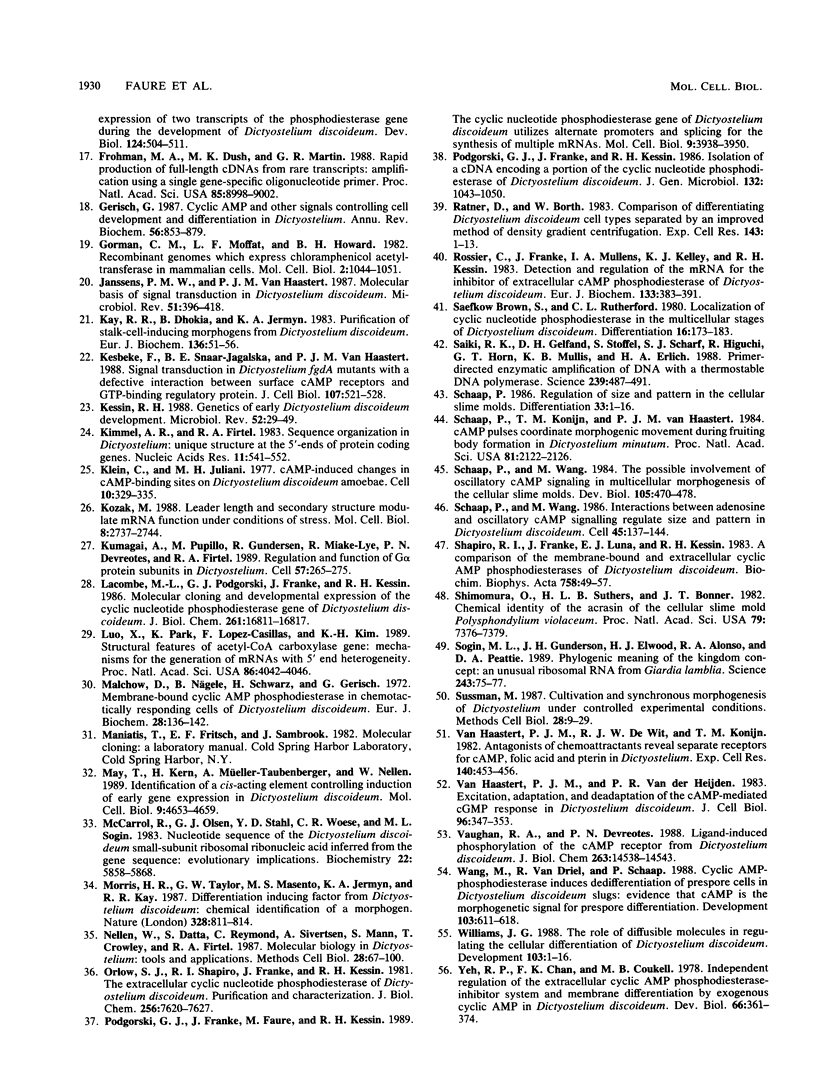
Images in this article
Selected References
These references are in PubMed. This may not be the complete list of references from this article.
- Barklis E., Lodish H. F. Regulation of dictyostelium discoideum mRNAs specific for prespore or prestalk cells. Cell. 1983 Apr;32(4):1139–1148. doi: 10.1016/0092-8674(83)90297-0. [DOI] [PubMed] [Google Scholar]
- Barra J., Barrand P., Blondelet M. H., Brachet P. pdsA, a gene involved in the production of active phosphodiesterase during starvation of Dictyostelium discoideum amoebae. Mol Gen Genet. 1980;177(4):607–613. doi: 10.1007/BF00272671. [DOI] [PubMed] [Google Scholar]
- Brown S. S., Rutherford C. L. Localization of cyclic nucleotide phosphodiesterase in the multicellular stages of Dictyostelium discoideum. Differentiation. 1980 Jun;16(3):173–183. doi: 10.1111/j.1432-0436.1980.tb01073.x. [DOI] [PubMed] [Google Scholar]
- Darmon M., Barra J., Brachet P. The role of phosphodiesterase in aggregation of Dictyostelium discoideum. J Cell Sci. 1978 Jun;31:233–243. doi: 10.1242/jcs.31.1.233. [DOI] [PubMed] [Google Scholar]
- Davis R. L., Davidson N. The memory gene dunce+ encodes a remarkable set of RNAs with internal heterogeneity. Mol Cell Biol. 1986 May;6(5):1464–1470. doi: 10.1128/mcb.6.5.1464. [DOI] [PMC free article] [PubMed] [Google Scholar]
- Devreotes P. Dictyostelium discoideum: a model system for cell-cell interactions in development. Science. 1989 Sep 8;245(4922):1054–1058. doi: 10.1126/science.2672337. [DOI] [PubMed] [Google Scholar]
- Early A. E., Williams J. G. Two vectors which facilitate gene manipulation and a simplified transformation procedure for Dictyostelium discoideum. Gene. 1987;59(1):99–106. doi: 10.1016/0378-1119(87)90270-8. [DOI] [PubMed] [Google Scholar]
- Faure M., Podgorski G. J., Franke J., Kessin R. H. Disruption of Dictyostelium discoideum morphogenesis by overproduction of cAMP phosphodiesterase. Proc Natl Acad Sci U S A. 1988 Nov;85(21):8076–8080. doi: 10.1073/pnas.85.21.8076. [DOI] [PMC free article] [PubMed] [Google Scholar]
- Faure M., Podgorski G. J., Franke J., Kessin R. H. Rescue of a Dictyostelium discoideum mutant defective in cyclic nucleotide phosphodiesterase. Dev Biol. 1989 Feb;131(2):366–372. doi: 10.1016/s0012-1606(89)80010-7. [DOI] [PubMed] [Google Scholar]
- Feinberg A. P., Vogelstein B. A technique for radiolabeling DNA restriction endonuclease fragments to high specific activity. Anal Biochem. 1983 Jul 1;132(1):6–13. doi: 10.1016/0003-2697(83)90418-9. [DOI] [PubMed] [Google Scholar]
- Firtel R. A., van Haastert P. J., Kimmel A. R., Devreotes P. N. G protein linked signal transduction pathways in development: dictyostelium as an experimental system. Cell. 1989 Jul 28;58(2):235–239. doi: 10.1016/0092-8674(89)90837-4. [DOI] [PubMed] [Google Scholar]
- Franke J., Kessin R. H. The cyclic nucleotide phosphodiesterase inhibitory protein of Dictyostelium discoideum. Purification and characterization. J Biol Chem. 1981 Jul 25;256(14):7628–7637. [PubMed] [Google Scholar]
- Franke J., Kessin R. A defined minimal medium for axenic strains of Dictyostelium discoideum. Proc Natl Acad Sci U S A. 1977 May;74(5):2157–2161. doi: 10.1073/pnas.74.5.2157. [DOI] [PMC free article] [PubMed] [Google Scholar]
- Frohman M. A., Dush M. K., Martin G. R. Rapid production of full-length cDNAs from rare transcripts: amplification using a single gene-specific oligonucleotide primer. Proc Natl Acad Sci U S A. 1988 Dec;85(23):8998–9002. doi: 10.1073/pnas.85.23.8998. [DOI] [PMC free article] [PubMed] [Google Scholar]
- Gerisch G. Cyclic AMP and other signals controlling cell development and differentiation in Dictyostelium. Annu Rev Biochem. 1987;56:853–879. doi: 10.1146/annurev.bi.56.070187.004225. [DOI] [PubMed] [Google Scholar]
- Gorman C. M., Moffat L. F., Howard B. H. Recombinant genomes which express chloramphenicol acetyltransferase in mammalian cells. Mol Cell Biol. 1982 Sep;2(9):1044–1051. doi: 10.1128/mcb.2.9.1044. [DOI] [PMC free article] [PubMed] [Google Scholar]
- Janssens P. M., Van Haastert P. J. Molecular basis of transmembrane signal transduction in Dictyostelium discoideum. Microbiol Rev. 1987 Dec;51(4):396–418. doi: 10.1128/mr.51.4.396-418.1987. [DOI] [PMC free article] [PubMed] [Google Scholar]
- Kay R. R., Dhokia B., Jermyn K. A. Purification of stalk-cell-inducing morphogens from Dictyostelium discoideum. Eur J Biochem. 1983 Oct 17;136(1):51–56. doi: 10.1111/j.1432-1033.1983.tb07703.x. [DOI] [PubMed] [Google Scholar]
- Kesbeke F., Snaar-Jagalska B. E., Van Haastert P. J. Signal transduction in Dictyostelium fgd A mutants with a defective interaction between surface cAMP receptors and a GTP-binding regulatory protein. J Cell Biol. 1988 Aug;107(2):521–528. doi: 10.1083/jcb.107.2.521. [DOI] [PMC free article] [PubMed] [Google Scholar]
- Kessin R. H. Genetics of early Dictyostelium discoideum development. Microbiol Rev. 1988 Mar;52(1):29–49. doi: 10.1128/mr.52.1.29-49.1988. [DOI] [PMC free article] [PubMed] [Google Scholar]
- Kimmel A. R., Firtel R. A. Sequence organization in Dictyostelium: unique structure at the 5'-ends of protein coding genes. Nucleic Acids Res. 1983 Jan 25;11(2):541–552. doi: 10.1093/nar/11.2.541. [DOI] [PMC free article] [PubMed] [Google Scholar]
- Klein C., Juliani M. H. cAMP,-induced changes in cAMP-binding sites on D; discoideum amebae. Cell. 1977 Feb;10(2):329–335. doi: 10.1016/0092-8674(77)90227-6. [DOI] [PubMed] [Google Scholar]
- Kozak M. Leader length and secondary structure modulate mRNA function under conditions of stress. Mol Cell Biol. 1988 Jul;8(7):2737–2744. doi: 10.1128/mcb.8.7.2737. [DOI] [PMC free article] [PubMed] [Google Scholar]
- Kumagai A., Pupillo M., Gundersen R., Miake-Lye R., Devreotes P. N., Firtel R. A. Regulation and function of G alpha protein subunits in Dictyostelium. Cell. 1989 Apr 21;57(2):265–275. doi: 10.1016/0092-8674(89)90964-1. [DOI] [PubMed] [Google Scholar]
- Lacombe M. L., Podgorski G. J., Franke J., Kessin R. H. Molecular cloning and developmental expression of the cyclic nucleotide phosphodiesterase gene of Dictyostelium discoideum. J Biol Chem. 1986 Dec 25;261(36):16811–16817. [PubMed] [Google Scholar]
- Luo X. C., Park K., Lopez-Casillas F., Kim K. H. Structural features of the acetyl-CoA carboxylase gene: mechanisms for the generation of mRNAs with 5' end heterogeneity. Proc Natl Acad Sci U S A. 1989 Jun;86(11):4042–4046. doi: 10.1073/pnas.86.11.4042. [DOI] [PMC free article] [PubMed] [Google Scholar]
- Malchow D., Nägele B., Schwarz H., Gerisch G. Membrane-bound cyclic AMP phosphodiesterase in chemotactically responding cells of Dictyostelium discoideum. Eur J Biochem. 1972 Jun 23;28(1):136–142. doi: 10.1111/j.1432-1033.1972.tb01894.x. [DOI] [PubMed] [Google Scholar]
- May T., Kern H., Müller-Taubenberger A., Nellen W. Identification of a cis-acting element controlling induction of early gene expression in Dictyostelium discoideum. Mol Cell Biol. 1989 Nov;9(11):4653–4659. doi: 10.1128/mcb.9.11.4653. [DOI] [PMC free article] [PubMed] [Google Scholar]
- Morris H. R., Taylor G. W., Masento M. S., Jermyn K. A., Kay R. R. Chemical structure of the morphogen differentiation inducing factor from Dictyostelium discoideum. 1987 Aug 27-Sep 2Nature. 328(6133):811–814. doi: 10.1038/328811a0. [DOI] [PubMed] [Google Scholar]
- Nellen W., Datta S., Reymond C., Sivertsen A., Mann S., Crowley T., Firtel R. A. Molecular biology in Dictyostelium: tools and applications. Methods Cell Biol. 1987;28:67–100. doi: 10.1016/s0091-679x(08)61637-4. [DOI] [PubMed] [Google Scholar]
- Orlow S. J., Shapiro R. I., Franke J., Kessin R. H. The extracellular cyclic nucleotide phosphodiesterase of Dictyostelium discoideum. Purification and characterization. J Biol Chem. 1981 Jul 25;256(14):7620–7627. [PubMed] [Google Scholar]
- Podgorski G. J., Franke J., Faure M., Kessin R. H. The cyclic nucleotide phosphodiesterase gene of Dictyostelium discoideum utilizes alternate promoters and splicing for the synthesis of multiple mRNAs. Mol Cell Biol. 1989 Sep;9(9):3938–3950. doi: 10.1128/mcb.9.9.3938. [DOI] [PMC free article] [PubMed] [Google Scholar]
- Podgorski G. J., Franke J., Kessin R. H. Isolation of a cDNA encoding a portion of the cyclic nucleotide phosphodiesterase of Dictyostelium discoideum. J Gen Microbiol. 1986 Apr;132(4):1043–1050. doi: 10.1099/00221287-132-4-1043. [DOI] [PubMed] [Google Scholar]
- Ratner D., Borth W. Comparison of differentiating Dictyostelium discoideum cell types separated by an improved method of density gradient centrifugation. Exp Cell Res. 1983 Jan;143(1):1–13. doi: 10.1016/0014-4827(83)90103-9. [DOI] [PubMed] [Google Scholar]
- Rossier C., Franke J., Mullens I. A., Kelley K. J., Kessin R. H. Detection and regulation of the mRNA for the inhibitor of extracellular cAMP phosphodiesterase of Dictyostelium discoideum. Eur J Biochem. 1983 Jun 15;133(2):383–391. doi: 10.1111/j.1432-1033.1983.tb07474.x. [DOI] [PubMed] [Google Scholar]
- Saiki R. K., Gelfand D. H., Stoffel S., Scharf S. J., Higuchi R., Horn G. T., Mullis K. B., Erlich H. A. Primer-directed enzymatic amplification of DNA with a thermostable DNA polymerase. Science. 1988 Jan 29;239(4839):487–491. doi: 10.1126/science.2448875. [DOI] [PubMed] [Google Scholar]
- Schaap P., Konijn T. M., van Haastert P. J. cAMP pulses coordinate morphogenetic movement during fruiting body formation of Dictyostelium minutum. Proc Natl Acad Sci U S A. 1984 Apr;81(7):2122–2126. doi: 10.1073/pnas.81.7.2122. [DOI] [PMC free article] [PubMed] [Google Scholar]
- Schaap P., Wang M. Interactions between adenosine and oscillatory cAMP signaling regulate size and pattern in Dictyostelium. Cell. 1986 Apr 11;45(1):137–144. doi: 10.1016/0092-8674(86)90545-3. [DOI] [PubMed] [Google Scholar]
- Schaap P., Wang M. The possible involvement of oscillatory cAMP signaling in multicellular morphogenesis of the cellular slime molds. Dev Biol. 1984 Oct;105(2):470–478. doi: 10.1016/0012-1606(84)90304-x. [DOI] [PubMed] [Google Scholar]
- Shimomura O., Suthers H. L., Bonner J. T. Chemical identity of the acrasin of the cellular slime mold Polysphondylium violaceum. Proc Natl Acad Sci U S A. 1982 Dec;79(23):7376–7379. doi: 10.1073/pnas.79.23.7376. [DOI] [PMC free article] [PubMed] [Google Scholar]
- Sogin M. L., Gunderson J. H., Elwood H. J., Alonso R. A., Peattie D. A. Phylogenetic meaning of the kingdom concept: an unusual ribosomal RNA from Giardia lamblia. Science. 1989 Jan 6;243(4887):75–77. doi: 10.1126/science.2911720. [DOI] [PubMed] [Google Scholar]
- Sussman M. Cultivation and synchronous morphogenesis of Dictyostelium under controlled experimental conditions. Methods Cell Biol. 1987;28:9–29. doi: 10.1016/s0091-679x(08)61635-0. [DOI] [PubMed] [Google Scholar]
- Van Haastert P. J., Van der Heijden P. R. Excitation, adaptation, and deadaptation of the cAMP-mediated cGMP response in Dictyostelium discoideum. J Cell Biol. 1983 Feb;96(2):347–353. doi: 10.1083/jcb.96.2.347. [DOI] [PMC free article] [PubMed] [Google Scholar]
- Vaughan R. A., Devreotes P. N. Ligand-induced phosphorylation of the cAMP receptor from Dictyostelium discoideum. J Biol Chem. 1988 Oct 5;263(28):14538–14543. [PubMed] [Google Scholar]
- Williams J. G. The role of diffusible molecules in regulating the cellular differentiation of Dictyostelium discoideum. Development. 1988 May;103(1):1–16. [PubMed] [Google Scholar]
- Yeh R. P., Chan F. K., Coukell M. B. Independent regulation of the extracellular cyclic AMP phosphodiesterase-inhibitor system and membrane differentiation by exogenous cyclic AMP in Dictyostelium discoideum. Dev Biol. 1978 Oct;66(2):361–374. doi: 10.1016/0012-1606(78)90245-2. [DOI] [PubMed] [Google Scholar]
- de Wit R. J., Konijn T. M. Identification of the acrasin of Dictyostelium minutum as a derivative of folic acid. Cell Differ. 1983 Apr;12(4):205–210. doi: 10.1016/0045-6039(83)90029-5. [DOI] [PubMed] [Google Scholar]
- van Haastert P. J., De Wit R. J., Konijn T. M. Antagonists of chemoattractants reveal separate receptors for cAMP, folic acid and pterin in Dictyostelium. Exp Cell Res. 1982 Aug;140(2):453–456. doi: 10.1016/0014-4827(82)90139-2. [DOI] [PubMed] [Google Scholar]



